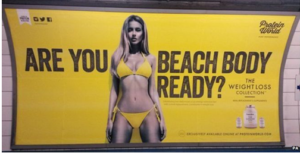
Advertisers have been using sexualised images to sell products since the 1900s and there is no sign of this trend letting up. However, Transport for London’s (TFL) ban on adverts promoting negative body image (think last year’s infamous ‘Are you Beach Body Ready?’ campaign) and a surge in public backlash are changing the risk profile of this strategy.
The ‘Are you Beach Body Ready?’ campaign, along with adverts for Jack Wills, Mac Cosmetics, Tom Ford, Miu Miu and Nobody’s Child are just a handful of ads that have fuelled the debate over the use of sexualised and body shaming images in advertising.
Complaints have highlighted a multitude of factors that are considered when determining an advert’s acceptability. These include location, wording in the advert, medium of publication and target audience which will all contribute to its level of appropriateness.
Whilst these factors are not new, what has changed is the presence of new stakeholders and pressures exerting control. Advertisers can no longer just consider the Advertising Standards Authority (ASA) rules, but must also take account of guidelines set by advertising space owners and the opinions of the public at large. These views, now amplified by social media poses an increasing challenge for advertisers to find the right tone.
Location
Location plays a key role in business performance, and for advertisers it’s one of their primary concerns.
With over 30 million user journeys per day, the London transport network is prime real estate for businesses advertising their products. TFL aims to generate revenue of over £3.4 billion in commercial advertising by 2023.
On 1 July 2016, TFL implemented a new advertising policy to ban adverts that are “not socially appropriate“, “distasteful, indecent or obscene“, or are likely to “create body confidence issues“.
The updated advertising policy follows the furore caused by the ‘Are you Beach Body Ready?’ campaign, mentioned earlier. The ad featured a bikini wearing model and was heavily criticised for “fat-shaming” women and “promoting an unrealistic body image“.

Photo source: http://www.bbc.co.uk/news/uk-33340301
Interestingly, the ASA did not ban the ad, even after receiving 378 official complaints. Instead, public reaction was the reason for its downfall. The ad sparked a public protest in Hyde Park on 2 May 2015 and a petition on Change.org, obtaining over 70,000 signatures, ultimately led to a (one-off) ban of the ad by TFL.
According to Sadiq Khan, Mayor of London, TFL’s new advertising policy will go one step further and ban adverts of this kind as a matter of course. On this basis, adverts of this type and a further estimated 12,000 adverts a year will no longer be allowed. These guidelines will apply across the whole network, including bus shelters and on-street sites.
The updated advertising policy gives TFL a broad discretion to accept or reject adverts, giving it the potential to significantly change the fabric of advertising on the London transport network.
Location
Advertisers must take into account any sensitive features of the surrounding area when looking for the optimal location for their target demographic. A Tom Ford advert featuring what was deemed a “sensual but not sexually suggestive” image of Cara Delevingne was on the advertising radar in April last year. The advert appeared in a “buzzy, urban and hip area” by Brick Lane in London. The advert was not banned by the ASA but it was advised that adverts of this nature should not appear within 100 meters of schools or places of worship.

Photo source: http://www.harpersbazaar.co.uk/fashion/fashion-news/news/a34313/should-this-cara-delevingne-ad-have-been-banned/
Location
The public prominence of the chosen medium is another key risk factor, and use of billboards and posters in public domains, catering for mass audiences, need to be particularly wary.
In June 2011, the Department of Education published “Letting children be children”, an independent report into the “commercialisation and sexualisation of childhood”. The aim was to reduce the exposure of children to sexualised images through newspapers, magazines, street advertising and pre watershed television. The ASA in a statement on sexual imagery in outdoor advertising have subsequently indicated that they will take a more robust approach to the protection of children from “inappropriate material“.
This stance can be seen from the ASA ruling in relation to the advert for the clothing brand, Nobody’s Child. It was found that the advert, which was displayed on bus shelters, portrayed a 21 year old model, “who appeared to be a child, in a way that was sexually suggestive and could be perceived as being vulnerable“. This perception was sufficient to lead to a ban, despite her actual age.

Photo source: http://www.campaignlive.co.uk/article/nobodys-child-ads-banned-sexualising-model-appearing-child/1389171#
Conversely, in September 2015, the ASA did not ban an advert for MAC Cosmetics, featuring the then 22 year old Miley Cyrus. The advert was located in multiple public places (the London Underground network and a shopping mall), depicting the celebrity icon in a “sexually suggestive” pose. It was decided that the image was not “overtly sexual“, and did not use “irresponsible sexual imagery” and therefore was not banned by the ASA.
 Photo source: http://www.campaignlive.co.uk/article/no-ban-miley-cyrus-sexually-suggestive-mac-cosmetics-ads/1365220
Photo source: http://www.campaignlive.co.uk/article/no-ban-miley-cyrus-sexually-suggestive-mac-cosmetics-ads/1365220
The ASA rulings for Nobody’s Child and Mac Cosmetics illustrate that whilst age is only a number, the model’s demeanour and pose are all important factors when determining if an ad is appropriate. Whilst Mac Cosmetics was seemingly “sexualising” an already confident persona, Nobody’s Child was deemed to be sexualising a younger looking model.
Appropriate to the audience…
Earlier this year, the ASA banned an advertising campaign for the British clothing brand Jack Wills, after it was considered “inappropriate for young people“. The ad featured images of a young group of friends dancing and drinking in their underwear, and in a bed together. The combination of the sequence of images, their obvious youth and the text “Pure and comfortable cottons, or flirty delicate laces; whatever your choice, you can be sure it’s what’s underneath that counts…” was sufficient for the ASA to conclude that it was socially “irresponsible“.

Photo source: http://www.telegraph.co.uk/news/2016/06/01/jack-wills-ad-banned-by-advertising-standards-authority-over-irr/
Whilst advertisers evidently need to be cautious when promoting goods to young people, there remain boundaries for adult-targeted publications as well. In May 2015, the ASA banned a double-paged Miu Miu advert, published in British Vogue. Although Vogue did not receive a complaint directly, the ASA ruling stated that “the model’s youthful appearance, in conjunction with the setting and pose, could give the impression that the ad presented a child in a sexualised way.”

Photo source: http://www.bbc.co.uk/newsbeat/article/32603741/irresponsible-prada-miu-miu-advert-banned-for-sexualising-a-model
The ASA gives no definition of what is deemed to be “irresponsible sexual imagery” and, as is apparent from the above, it is not always easy to draw a clear line between what it acceptable and what is not. What is clear is the trend towards a more protective attitude in general and the risk of public backlash if the limits of taste are pushed too far.









